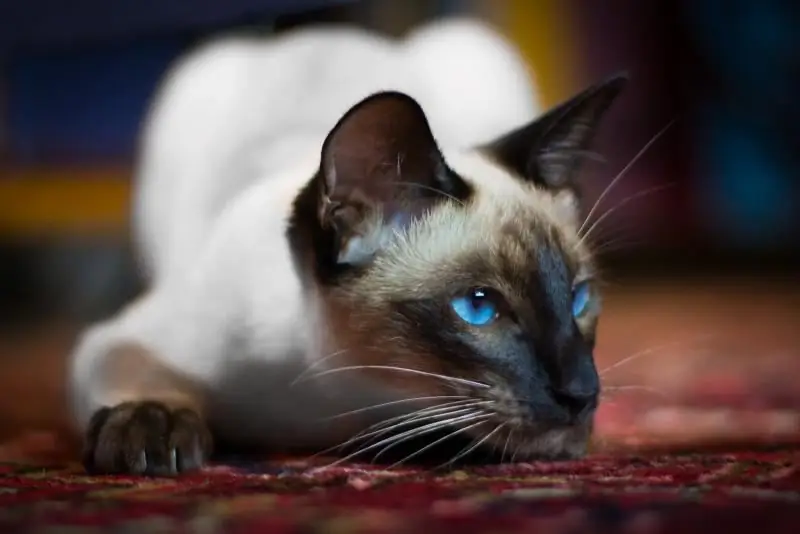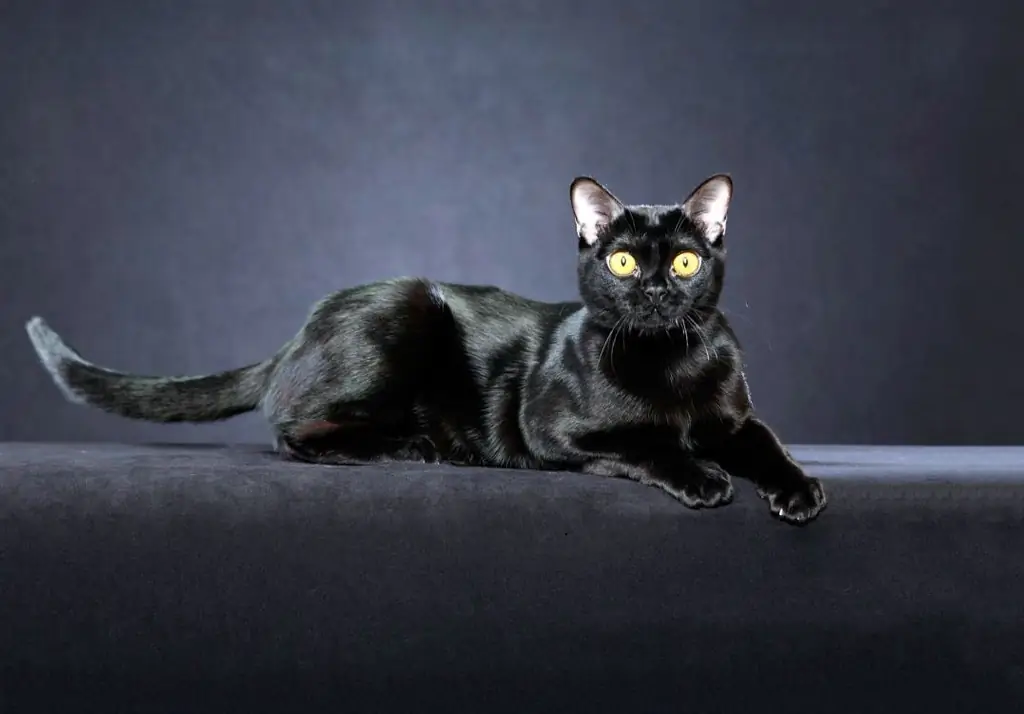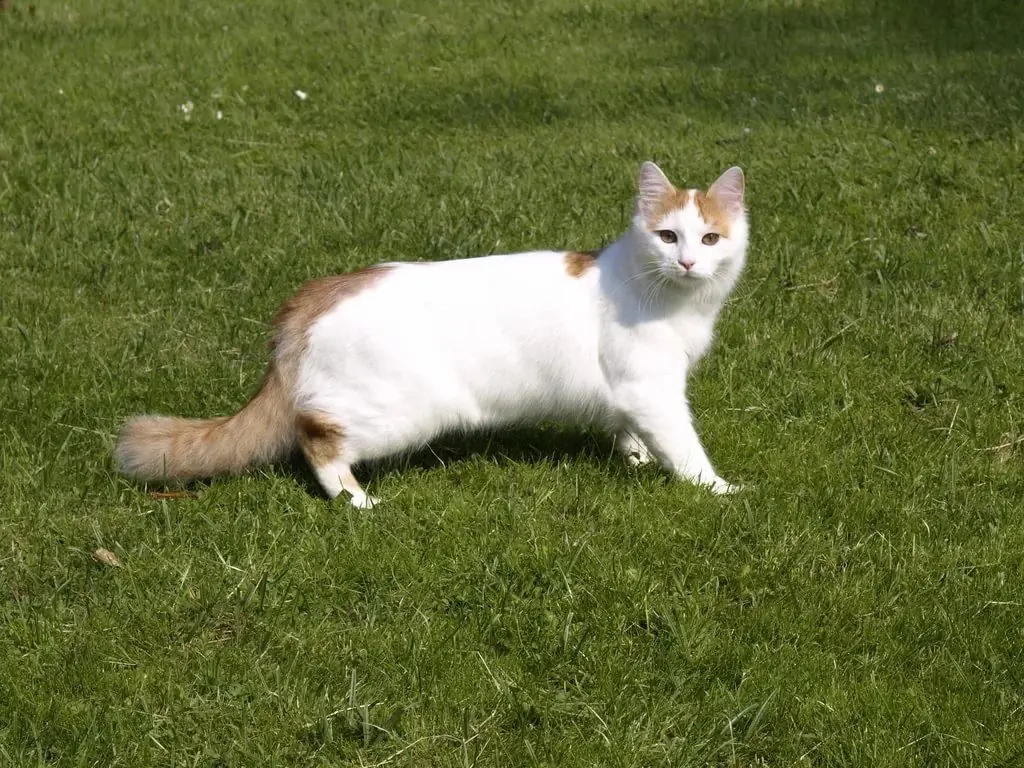
Table of contents:
- Ural rex - an angel in sheep's clothing
- History of the origin of the breed
- Features of the Ural Rex
- Health
- How to choose a kitten of the Ural Rex
- How to care for the Ural rex
- Breeding the Ural Rex
- Castration and sterilization
- Video: about the breed of cats Ural Rex
- Reviews of the owners about the breed
- Author Bailey Albertson [email protected].
- Public 2024-01-17 22:26.
- Last modified 2025-06-01 07:32.
Ural rex - an angel in sheep's clothing

What breeds of cats do not exist in the world! And fluffy, and bald, and even curly like lambs. One of these unusual and rare breeds is the Ural rex.
Content
- 1 History of the origin of the breed
-
2 Features of the Ural Rex
- 2.1 Photo gallery: Ural rex
- 2.2 Character and behavior
- 3 Health
-
4 How to choose a kitten of the Ural Rex
4.1 Photo gallery: kittens of the Ural Rex, Devon Rex and Cornish Rex
-
5 How to care for the Ural rex
- 5.1 Toilet
- 5.2 Feeding
- 6 Breeding the Ural Rex
- 7 Castration and sterilization
- 8 Video: about the breed of cats Ural Rex
- 9 Host reviews about the breed
History of the origin of the breed
The breed was bred in Russia, or rather, in the Urals. Despite the fact that one could hear about curly cats in this area already in the 40s of the XX century, the date of appearance of the breed is considered to be 1988, when in the Sverdlovsk region L. S. Podurovskaya, the ancestor of the Ural Rex breed Vaska of black bicolor color appeared. His mother was an ordinary straight-haired mongrel cat. The tribal base was laid by kittens that appeared as a result of crossing Vaska with his mother. Later, similar cats were found in the Urals.

The founder of the breed is the cat Vaska
The World Cat Federation (WCF) recognized the Ural Rex in 2006, and the International Felinological Association (IPA) in 2012. Unfortunately, other felinological associations do not recognize this breed.
Features of the Ural Rex
According to the standard of the World Cat Federation, the Ural Rex must have specific external characteristics:
- the body is of medium size, muscular and relatively short, but still slender and elegant;
- legs of medium length, slender with oval paws;
- the tail is of medium length, not wide at the base, tapering to a slightly rounded tip;
- the head is a short, wide, equilateral wedge;
- wide flat forehead;
- the profile is slightly curved at the level of the lower eye sockets;
- the cheek bones are pronounced, the muzzle is wide, the chin and lower jaw are strong;
- ears of medium size with rounded tips, set high on the head and set vertically;
- the eyes are large, oval and oblique, widely spaced, the color of the eyes corresponds to the color.
The coat is semi-long and dense, the hairs are thin, soft, silky. The coat on the whole body and tail forms dense plane waves. The peculiarity of this breed is the amazing elasticity of the wave. Curls are spiral or in the form of curls. It should be noted that the curls of the Ural Rex differ from the waves of the Cornish or Devon Rex, since different genes are responsible for the waviness of the coat. The Ural rex practically does not shed, which greatly facilitates the life of the owner.

The wool of the Ural is thin, soft and silky
Any color is acceptable, except for the color of chocolate and cinnamon, as well as their dilution (lilac and fawn). Their presence is unacceptable even in combinations (bicolor, tricolor, tabby). In addition, the colors of the Abyssinian tick and the color of the Burmese are unacceptable. The presence of white is acceptable in any quantity.
The disadvantages are:
- narrow elongated head;
- excessively large or, conversely, small ears;
- straight profile;
- rounded eyes;
- squat body.
Photo gallery: Ural Rex
-

Tricolor Ural Rex - Any amount of white in the color of the Ural Rex is allowed
-

Black Ural Rex -
A feature of the Ural Rex is its curly coat
-

Ural rex - Ural rexes come in various colors
Character and behavior
These curly haired angels have a docile character. They are affectionate and playful, and get along well with children and pets. Strangers are treated kindly. Ural Rexes are absolutely not aggressive, at exhibitions they behave with dignity and calmness, without worrying when judges examine them. Moreover, the temper of these cats is quite lively. Especially in childhood, they touch the owners with their funny antics.
The Ural Rex does not tolerate loneliness, so this cat should not be gotten by those who are rarely at home
Health
The health of the Ural rex is good. No genetic diseases were identified. The average life span of cats of this breed is 14 years.
How to choose a kitten of the Ural Rex
It is best to buy a Ural Rex kitten in a cattery with a good reputation. Buying an animal at the “bird market” or from the hands of an ad may turn out to be disappointing: the kitten may turn out to be non-purebred.

When buying, the seller will give the pet's pedigree and veterinary passport
It is not recommended to buy a kitten earlier than 3 months, as:
- it is difficult to confirm belonging to the breed before this age;
- up to 3 months, the kitten is still very attached to its mother, and it is wrong to separate them at such a young age;
- only by this age does the baby adopt many positive habits from his mother.
In addition to the signs of the breed, when buying a kitten, you must definitely pay attention to its health. Signs of a healthy kitten are:
- clean eyes, ears and anus;
- curiosity and lack of fear of strangers;
- soft, not bloated tummy;
- lack of bald spots on the woolen cover;
- the coat should not be tousled or matted;
- pink, non-flaking skin.
When making a choice between a cat or a cat, first of all think about why you have a pet. If your goal is to start breeding these beautiful cats in the future, then choose a female. The temperament of these animals is very playful, but cats are more affectionate. Cats are more active.
When assessing belonging to the breed, pay attention to the external characteristics of the kitten. Ural Rex at 3 months already has small characteristic curls, which will become pronounced by 6 months. Whereas the Cornish Rex and Devon Rex often at this age have a straight coat, which begins to curl a little later.

In a Ural Rex kitten, curly waves on the coat begin to appear as early as 3 months
In addition to differences in coat, cats of these breeds have very different appearance. Cornish Rexes have unusually large ears and a characteristic profile, the face of the Devon Rex is shaped like a triangle. And the Ural Rex most of all look like an ordinary European cat, if you do not take into account the unusual wool.
Photo gallery: kittens of the Ural Rex, Devon Rex and Cornish Rex
-

Devon Rex kittens - Little Devon Rexes have an incredibly cute face
-

Cornish Rex kittens - In Cornish kittens, special attention is attracted by wide, high set ears
-

Ural rex kitten - Small Ural Rex quickly acquire curly hair
The cost of a Ural Rex kitten depends on the class of the animal. All kittens are divided into 3 classes:
- Pet-class animals are intended to be pets only, they cannot participate in breeding or in exhibitions due to minor defects, which, however, do not prevent them from taking their place in the heart of the owner. The price of such kittens of the Ural Rex breed in nurseries is 15-30 thousand rubles.
- Breed-class kittens are intended for breeding. They can participate in exhibitions, but do not take prizes due to minor deviations in appearance. However, such cats are capable of producing wonderful offspring. Their price can be about 25-45 thousand rubles.
- Show class is represented by cats of the highest show class. Their exterior is fully consistent with the breed standard. But the cost of such kittens is much higher, on average it is about 35-50 thousand rubles.
How to care for the Ural rex
Despite its exotic appearance, the Ural Rex does not require complex maintenance. Cleaning the ears as they become dirty, brushing your teeth once every 7-10 days and trimming your nails every 2-3 weeks should be done in the same way as for cats of other breeds. The peculiarity of caring for the Ural rex lies in the uniqueness of their wool. Dead hairs in the Urals do not fall out on their own, as they get stuck among the curls, therefore, weekly brushing of these cats (1-2 times in 7 days) with special combs should become a habit. During the molting period, combing should be done every other day. For these purposes, soft brushes with natural bristles or a comb with short teeth are good, which do not damage the hair structure.
It is necessary to bathe Ural rexes as rarely as possible, only as the wool becomes dirty, since their skin is very delicate. According to the reviews of Rex owners, shampoos such as 1All systems, which improve the texture of the coat, and 8in1 Perfect Coat SHED CONTROL & HAIRBALL SHAMPOO can be distinguished.

You rarely need to bathe the Urals residents, using special shampoos
Restroom
Ural Rex are very smart cats, so usually litter training is not difficult. They are also not picky about the container and cat litter. The main thing is that the kitty can be safely placed in the tray. Therefore, the owner can independently choose a more convenient option for himself and the pet.
Feeding
You can feed the Ural Rex with both natural products and ready-made industrial feed. When choosing the latter, you need to remember that budget food (both dry and wet) is not suitable for this breed of cats. For them, you need to choose premium and super premium food. For example, ROYAL CANIN, JAMS, HILLS.
When choosing natural products, you need to remember that 1/3 of the daily menu should consist of protein (lean meat, offal, boiled fish), 1/3 of cereals (oatmeal, buckwheat, rice groats), and 1/3 should be fruits and vegetables
It is important to remember that cats are prohibited from giving the following foods:
- bread, cookies, pastries and more;
- sugar and sweets (chocolate - in no case);
- pasta;
- mushrooms;
-
onion;

Toxic food for cats Eating some food can kill the animal
- garlic;
- hot pepper and other spices;
- salted, pickled, smoked products;
- ketchup, mayonnaise and other sauces;
- yoghurts with sugar and fillers.
The number of feedings depends on the age of the pet:
- babies up to 3 months need frequent feeding (5-6 times a day);
- up to six months, kittens need to be fed 4 times a day:
- up to 8 months - 3 times;
- starting from 8 months, the pet can be transferred to two meals a day.
An adult cat needs about 40 g of natural food per 1 kg of weight, but the amount of daily food should not exceed 250 g. For kittens, there are their own portion sizes, which depend on the age of the baby:
- 1-2 months - 120-150 g of food (with 6 meals a day);
- 3-6 months - 180-240 g (with 4 meals a day),
- 6-8 months - 200-250 g (with three meals a day);
- 9-12 months - 150-200 g of food (two meals a day).
Breeding the Ural Rex
If you want your beloved kitty to give offspring, you need to remember that Ural Rex should not be bred with cats of other breeds
Puberty in cats of this breed occurs at about 8-9 months. But it is not recommended to bring both a cat and a cat at such a young age, since the animal's body is not yet ready to function as an adult. The optimal time for first mating is about a year and a half.
The pregnancy of the Ural Rex proceeds without any peculiarities. One litter usually contains from 2 to 4 kittens.
Castration and sterilization
Ordinary people often use the terms castration and sterilization in relation to the sex of the animal. It is customary for us to think that only males are castrated, and cats are sterilized. However, you need to know that the use of these concepts in this sense is incorrect. In medical practice, these two operations do not have gender:
- castration is the removal of reproductive organs in animals: in males, the testes are removed, and in females, castration can be partial - only the ovaries are removed or complete - the ovaries are removed along with the uterus;
- sterilization is an operation to remove reproductive organs from female animals and remove testes from male animals.
There is no consensus regarding the best age for these operations. It is believed that the optimal time for the cessation of reproductive functions is the age of 7-8 months, that is, before the animal becomes sexually mature. Some veterinarians believe that it is better to perform these operations at an even earlier age.

It is better to carry out the operation before the animals reach puberty.
Video: about the breed of cats Ural Rex
Reviews of the owners about the breed
The Ural Rex is an unpretentious and unusual cat. Its main distinguishing feature is its wavy coat. The Urals can be seen infrequently, as the breed is still very young. But, once seeing and touching her soft skin, you fall in love with this breed immediately.
Recommended:
Siamese Cat: Description Of The Breed, Character And Habits, Owner Reviews, Photos, Kitten Selection, Difference From Thai Cats

Everything you need to know about the Siamese cat: the history of the breed, how Siamese cats differ from Thai cats, how to care for them, how to choose purebred kittens
Siberian Cat: Description Of The Breed And Character, Photo, Choice Of A Kitten, Owner Reviews

History of the Siberian cat breed. Appearance, character traits. Care and feeding. How to choose a kitten of this breed. Features of breeding. Reviews
Bombay Cat: Cat Photo, Price, Breed Character, External Standards, Breeding, Kitten Selection, Owner Reviews

Where is the Bombay cat bred, what are the main external differences and character, how to properly care for it, feed it, how to choose a kitten of this breed
Turkish Van: Photo Of A Cat, Description Of The Breed, Character And Habits, Owner Reviews, Choice Of A Van Kitten

Where did the Turkish Van breed appear, what are the main external differences and character. How to properly care for the breed, how to choose a kitten. Host Reviews
Devon Rex: Cat Photo, Price, Nature And Description Of The Breed, Owner Reviews, How To Choose A Kitten In The Cattery, Pet Care

Description of the breed of cats Devon Rex. History of origin, features of appearance and care. The nature and common diseases. Owner reviews
